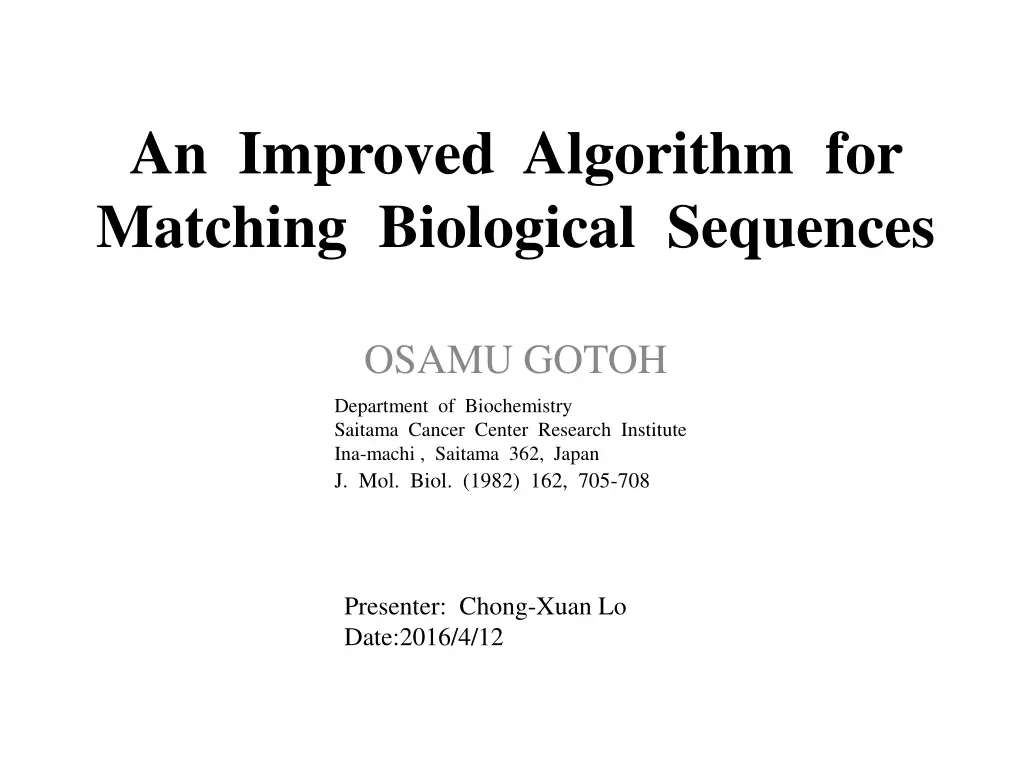
Improved Algorithm for Matching Biological Sequences by Osamu Gotoh
Discover the innovative approach introduced by Osamu Gotoh in matching biological sequences, enhancing the efficiency of sequence alignment for practical applications while reducing computational complexity. Learn about the modifications to the Waterman et al. algorithm and how the affine gap penalty method optimizes sequence matching. Explore Gotoh's algorithm step-by-step and its application in aligning biological sequences accurately with reduced computational resources.
Uploaded on | 0 Views
Download Presentation

Please find below an Image/Link to download the presentation.
The content on the website is provided AS IS for your information and personal use only. It may not be sold, licensed, or shared on other websites without obtaining consent from the author. If you encounter any issues during the download, it is possible that the publisher has removed the file from their server.
You are allowed to download the files provided on this website for personal or commercial use, subject to the condition that they are used lawfully. All files are the property of their respective owners.
The content on the website is provided AS IS for your information and personal use only. It may not be sold, licensed, or shared on other websites without obtaining consent from the author.
E N D
Presentation Transcript
An Improved Algorithm for Matching Biological Sequences OSAMU GOTOH Department of Biochemistry Saitama Cancer Center Research Institute Ina-machi , Saitama 362, Japan J. Mol. Biol. (1982) 162, 705-708 Presenter: Chong-Xuan Lo Date:2016/4/12
Abstract The algorithm of Waterman et al. (1976) for matching biological sequences was modified under some limitations to be accomplished in essentially MN steps, instead of the ?2N steps necessary in the original algorithm. The limitations do not seriously reduce the generality of the original method, and the present method is available for most practical uses. The algorithm can be executed on a small computer with a limited capacity of core memory.
Affine gap penalty The affine gap penalty combines the components in both the constant and linear gap penalty, taking the form +(k ). - gap opening penalty - gap extension penalty k - the length of the gap
Gotohs algorithm A = a1a2 ai am B = b1b2 bj bn Di,j - cost for alignment of prefixes (a1 .am,b1 bn) Pi,j - cost for alignment of prefixes (a1 .am,b1 bn) that ends with a gap in b (i.e. last column is ?? ) Qi,j - cost for alignment of prefixes (a1 .am,b1 bn) ??) that ends with a gap in a (i.e. last column is
Gotohs algorithm A = a1a2 ai am B = b1b2 bj bn Di,j = min[Di-1,j-1+w(ai,bj) , Pi,j , Qi,j] Pi,j = min[Di-1,j + , Pi-1,j + ] (deletion gap opening) (deletion gap extension) Qi,j = min[Di,j-1 + , Qi,j-1+ ] (insertion gap opening) (insertion gap extension) with i,j 1, where for 1 ? |?| and 1 ? |?|
Gotohs algorithm Example: A = CC and B = GCCT Cost functions: Match : w(ai,bj) = 0 ?? ?? = ?? 1 ???? gap penalty : g(k)=7 + 2k
Gotohs algorithm Match : w(ai,bj) = 0 ?? ?? = ?? 1 ???? gap penalty : g(k)=7 + 2k G C C T 0 7 9 11 13 Di,j C 7 12 1 7 9 7 C 9 8 1 10 Di,j= min[Di-1,j-1+w(ai,bj) , Pi,j , Qi,j] (Match) Qi,j = min[Di,j-1 + , Qi,j-1+ ] G C C T Pi,j = min[Di-1,j + , Pi-1,j + ] 0 Qi,j 12 10 14 8 C C Traceback: 1. C C - - G C C T 16 15 8 10 (Inserion) G C C T 0 2. - - C C G C C T Pi,j C 14 16 18 20 14 C 8 19 16 (deletion)
Gotohs algorithm Affine gap as finite state machine
Gotohs algorithm Time complexity : O (mn)
